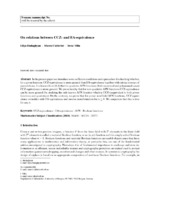| dc.contributor.author | Villa, Irene | |
| dc.contributor.author | Calderini, Marco | |
| dc.contributor.author | Budaghyan, Lilya | |
| dc.date.accessioned | 2020-05-14T13:24:14Z | |
| dc.date.available | 2020-05-14T13:24:14Z | |
| dc.date.issued | 2020 | |
| dc.Published | Villa I, Calderini M, Budaghyan L. On relations between CCZ- and EA-equivalences. Cryptography and Communications. 2020;12:85-100 | eng |
| dc.identifier.issn | 1936-2455 | en_US |
| dc.identifier.issn | 1936-2447 | en_US |
| dc.identifier.uri | https://hdl.handle.net/1956/22273 | |
| dc.description.abstract | In the present paper we introduce some sufficient conditions and a procedure for checking whether, for a given function, CCZ-equivalence is more general than EA-equivalence together with taking inverses of permutations. It is known from Budaghyan et al. (IEEE Trans. Inf. Theory 52.3, 1141–1152 2006; Finite Fields Appl. 15(2), 150–159 2009) that for quadratic APN functions (both monomial and polynomial cases) CCZ-equivalence is more general. We prove hereby that for non-quadratic APN functions CCZ-equivalence can be more general (by studying the only known APN function which is CCZ-inequivalent to both power functions and quadratics). On the contrary, we prove that for power non-Gold APN functions, CCZ equivalence coincides with EA-equivalence and inverse transformation for n ≤ 8. We conjecture that this is true for any n. | en_US |
| dc.language.iso | eng | eng |
| dc.publisher | Springer | en_US |
| dc.title | On relations between CCZ- and EA-equivalences | en_US |
| dc.type | Peer reviewed | |
| dc.type | Journal article | |
| dc.date.updated | 2020-01-17T14:36:56Z | |
| dc.description.version | acceptedVersion | en_US |
| dc.rights.holder | Copyright 2019 Springer | en_US |
| dc.identifier.doi | https://doi.org/10.1007/s12095-019-00367-5 | |
| dc.identifier.cristin | 1776069 | |
| dc.source.journal | Cryptography and Communications | |
